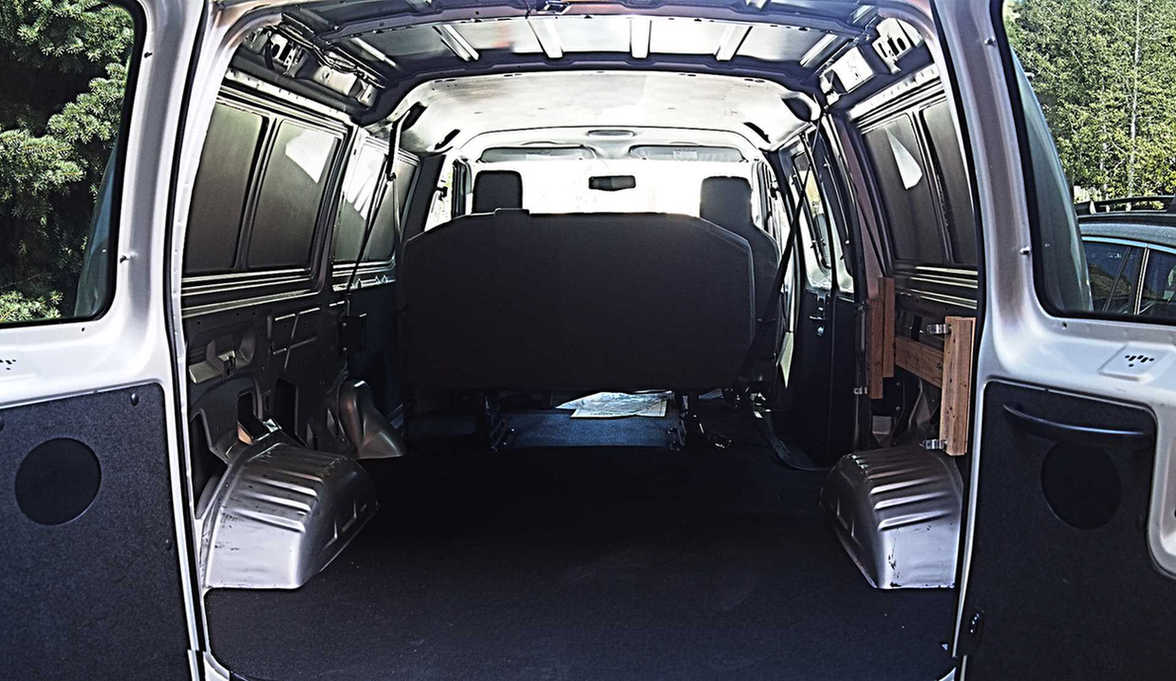I recently plonked down a bunch of dough to buy a cargo vehicle. If you are a show-production human or a musician, you are probably going to end up doing the same thing at some point.
Let’s face it, gear is large and heavy, and at some point you’ll want to haul more than what a regular passenger car will let you get away with.
Vehicles are a major expense, and in fact, that’s my first tip: A vehicle should be a significant expense. This is not to say that you should be reckless with your money – you should buy well within your means. At the same time, you should buy a vehicle that’s worth having. All that cool gear that you’ve researched, tweaked, and horse-traded for? It’s worthless if you can’t get it to the gig. So, if you wouldn’t buy a half-dead guitar that’s on sale for $50, why would you buy a half-dead cargo hauler that’s on sale for $500?
A vehicle is an investment in the future of your profession, so treat the decision like it actually matters.
(Side note: Yes, you can trade purchase-price for a willingness to work on the vehicle yourself. If you’re determined to buy a $500 mechanic’s special, be sure you’re actually a mechanic.)
Please be aware that this is NOT a definitive guide to purchasing a cargo vehicle. I would consider this a decent primer based on my experience, but I’m only slightly less new to all this than you are.
Decide What Actually Fits Your Logistics
First of all, you have to figure out what you’re hauling. Gear? Humans? Both? Humans require a LOT of space, so take that into account if your “ship” is going to have to do double duty.
Especially if your prospective van is going to be all things to all people, be ready to find something in the heavier-duty range. Basic models won’t cut the mustard, especially if you need to fill the main vehicle…and then add a trailer. Do your best to overestimate the space AND (very important) the weight of what you’re going to haul around, because you want to avoid a vehicle that can just barely handle either one. In my own case, I thought I was overestimating, and I basically hit my cargo volume right on with a bit of play in the gross weight. It’s very easy to think you’re getting more van than you actually are.
I myself am not planning to add a trailer anytime soon. However, my personal feeling on trailers is that you want to have the actual leftover capacity to pull the maximum GVWR (Gross Vehicle Weight Rating) of whatever trailer you’re interested in. That is, don’t assume you’re only going to pull what you’re going to pull right now. Rather, act as though a trailer capable of operating at a certain gross weight actually has that much mass when empty. It’s much safer to overestimate your potential vehicle weight than to low-ball. Remember that the more internal payload you have in the van, the less trailer you can pull. Yes, the Gross Combined Weight Rating (GCWR) really does matter, and no, you should not play any head games with that number. Safety matters a lot. Other things that matter a lot are your engine and transmission, and they don’t like being overloaded.
Now, with all that, there’s a wrinkle you have to keep in mind: The bigger the vehicle gets, the tougher the care and feeding can be. Parking a big vehicle can be a real bear; Be ready to tell show organizers that you absolutely MUST have a ready-made place to put vehicles with a total combined length of however much you’ve managed to string together. The bigger it is, the tougher it is to store. The bigger it is, the more fuel it will consume – and be aware that getting into really “big dog” territory may require you to get a van with a diesel power plant. (Diesel isn’t anything to be frightened of, but it’s not as familiar as gasoline in the USA, and not every mechanic can work on diesel engines.)
Consult The Car Gurus
Making use of more than one online vehicle listing service is very helpful, but in my opinion, CarGurus.com is the place to spend most of your time. It has one of the better search interfaces out there, where the listed automobiles can be generally counted on to have been posted with all the relevant information provided. The point is that you don’t want to spend time hunting around in “free-text” for the specs you want. At CarGurus, you can ask for a lot of specifics, and if those specifics haven’t been put in correctly by the seller – well, that’s too bad for them. The vehicle won’t show.
In my opinion, you should start this bit several months before you actually want to make your purchase. Do lots of searches. See what’s out there. Change your mind a few times. Stop and think. Just like when setting up for a show, you don’t want to shop for a van while under the gun.
As far as my own personal feelings about what to look for:
- Buy from a dealer. I’m not saying that a private-party sale can’t be okay, but dealers are meaningfully regulated; You have at least some chance of official recourse if you end up getting bit, and a dealer running a legitimate business has real reasons to want to preserve that business.
- If it’s less than five years old, you’re probably paying a big premium on newness and depreciation.
- On the flipside, a vehicle with more than 10 years on the clock is going to be more of a risk in terms of general deterioration.
- Cargo vehicles are meant to go a long way over the course of their lives. Even so, 150,000 miles is probably the maximum that want to see on an odometer. I would personally consider that the point for most of the original parts to be at least “halfway used up.” (I’m really not a car guy, but I can do some educated guessing.)
- If the engine doesn’t have at least eight cylinders, be wary of it. Even a smallish van is a heavy creature. Also, remember that not all engines are created equal. More displacement rather than less is generally a good idea, if you have the choice.
- Filter out anything that has frame damage reported. The frame is a fundamental, bedrock part of the vehicle, and “one shot.” Again, I’m not really a car guy, but everything I’ve heard has lead me to believe that an automobile’s frame is not really “unscrewuppable” after it’s taken a major hit. If you’re going to save money, don’t save money by way of the frame.
- Also, set that “Accidents Reported” slider to zero. You’ll have fewer vehicles to choose from, but they’ll be the ones that weren’t unloaded due to being wrecked.
- Anything other than a clean title means “no deal.”
- A vehicle tall enough for you to stand up straight in is really neat, but will cost you. It will also be tougher to drive, harder to find indoor parking for, and likely to catch crosswind in a manner similar to a kite.
- Hydraulic lifts are a neat idea, but remember that they have real weight, take up space, and are a whole separate mechanical component that your average auto shop can’t be counted on to know how to deal with.
- Cargo vans have an alarming tendency to have a bunch of shelving and other crap bolted into them. For electricians, plumbers, and other similar trades, shelving is a plus. For audio, not so much. It’s a waste of space and weight.
- Look carefully at the pictures. Does the poor thing have the appearance of being abused? The appearance is likely the reality. Also, if the seller only shows one side of the vehicle, ask yourself what’s being hidden.
- Obviously, you should not buy an overpriced vehicle. Also, though, be wary of anything listed way below the market rate. The seller might be trying to throw out a problem child.
- Backup cameras and backup sensors are a really good idea. Even if you’re good at knowing where all parts of a big automobile are at all times (I’m not), all the assistance you can get with maneuvering will be helpful.
Get yourself a short-list of candidates, and then…
Get Your Mitts On One Of Those Suckers
Go look at your favorites. Physically. And REALLY look. Get close to everything and note the wear and tear. Ask to have the hood opened. Get on your hands on knees and take a serious gander at the undercarriage. If it seems sketchy and beat-up, guess what – it is. You don’t have to be an expert to notice if something major is rusting through, leaking profusely, or otherwise about to fall off your potential purchase.
Remember, by the way, to be cordial, friendly, and patient with the dealer. Smile, shake hands, try to look people in the eye, and have a sense of humor. Bring your best manners, and if your best manners aren’t all that great, bring the manners that belong to a respectable somebody else. Being picky requires being nice. If you’ve got an attitude, that needs to stay home. Say “please” and “thank you” at every opportunity.
Also, do some feeling around. Get your hands up in the body and interior overhangs, claw around a bit, and see if you come back with dirt, leaves, sticks, or other debris. If you do, that’s a bad sign. The vehicle may have been flooded. Use your nose, too, because a van that smells like it’s been sitting at the bottom of a swamp may indeed have been home to water, mud, alligators, and a wayward outboard motor or two.
Ask to see any and all documentation that came with the vehicle. Get a Carfax (or the equivalent), and actually read through it. You want to know as much about the van as your brain can hold.
You did bring your driver’s license, right? Good, because if the vehicle doesn’t scare you, you do want to drive it.
Try to get a feel for how the van behaves in a variety of situations. Try some non-trivial maneuvering in reverse. See what the thing is like on surface streets, and also on the freeway. (A vehicle can be fine at low speeds…and downright terrifying on the highway.) Can you see what you’re doing? Does changing lanes cause an unsafe spike in blood pressure? Are the mirrors actually helpful? What do the brakes feel like when used normally? What do the brakes feel like when you really get on them? (Seriously, folks, be sure that the brakes don’t scare you. It’s far better to be stopped, desperately wishing that you were moving, than to be moving, desperately wishing you could stop. If the brakes don’t feel smooth and perfect, forget about it.) A real road test doesn’t – and shouldn’t – take a whole day, but you also need more than the five minutes it takes to find the pedals and the turn signal.
Use these hands-on experiences to work up your short, short, short list, and then pick your favorite.
The next thing to do is to have the short-list leader inspected by a third-party mechanic. At the very, very least, take the vehicle to a dealer who sells brand-new versions of whatever you’re buying, and have their service department do a “tell me what’s wrong” workup. If you’re serious about the van, but have some misgivings, make an appointment for a more thorough, more extensive going-over. It will cost you some money, but you’ll know more.
If things still look okay, you’re ready to “light the candle.” Ask about what proof of insurance will be necessary to drive the van off the lot, and then procure whatever is necessary to get that proof immediately before taking actual possession. After that, put as much real “cash” as is prudent into the purchase, so as to minimize any interest payments to be made on financing. Remember that there are fees aplenty that get tacked onto the advertised price, so multiply the sticker by about 1.1 to get into the ballpark.
When it’s all said and done, you should have a basically decent vehicle that you can put to work.

 Want to use this image for something else? Great! Click it for the link to a high-res or resolution-independent version.
Want to use this image for something else? Great! Click it for the link to a high-res or resolution-independent version.



